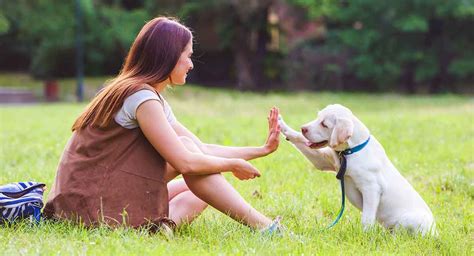Welcome to our latest blog post, where we’ll be discussing the essential tips for training your beloved four-legged friend. Whether you’re a first-time pet owner or looking to brush up on your dog training skills, understanding your dog’s behavior is the first step towards a successful training journey. Establishing a consistent routine and using positive reinforcement training techniques are crucial for effectively communicating with your furry companion. In addition, we’ll cover the importance of socializing your dog with other animals, as well as how to address common training challenges. We’ll also delve into teaching basic commands such as sit, stay, and come, while also addressing separation anxiety in dogs. And if you’re ready to take your dog’s training to the next level, we’ll provide some insights into advanced training for obedience and tricks. So, grab a cup of coffee, cozy up with your pup, and let’s dive into these 5 essential tips for training your dog.
Understanding Your Dog’s Behavior
Dogs are known for their loyalty and affection towards their owners. It is important for dog owners to understand the behavior of their furry friends in order to build a strong and lasting bond with them.
One key aspect of understanding your dog’s behavior is to observe their body language. Dogs communicate through their body language, such as wagging their tails when they are happy, or tucking their tail between their legs when they are anxious or scared.
Another important factor in understanding your dog’s behavior is to consider their breed. Different dog breeds have different temperaments and behaviors. For example, certain breeds may be more prone to separation anxiety, while others may be more energetic and playful. Understanding the typical behaviors of your dog’s breed can help you better meet their needs and provide appropriate training and socialization.
Furthermore, it is crucial to consider the environment in which your dog was raised. Dogs that have been mistreated or have had negative experiences in the past may exhibit certain behavioral issues. Understanding your dog’s past can help you address any underlying issues and provide the necessary support and training to help them overcome any behavioral challenges.
Establishing a Consistent Routine
Establishing a consistent routine for your dog is essential for their overall well-being and behavior. Dogs thrive on routine and structure, so it’s important to establish a daily schedule that includes regular feeding times, exercise, training, and rest. By creating a consistent routine, you can help your dog feel more secure and reduce the likelihood of behavioral issues.
One important aspect of establishing a consistent routine is to set a regular feeding schedule for your dog. This means feeding them at the same times every day and providing them with the appropriate amount of food for their size and activity level. By doing so, you can help prevent overeating or undereating, and reduce the risk of digestive issues.
In addition to regular feeding times, it’s crucial to incorporate daily exercise into your dog’s routine. Dogs have different exercise needs depending on their breed, age, and overall health, so it’s important to tailor their exercise routine to meet their specific needs. Whether it’s a brisk walk, a game of fetch, or interactive play, providing daily exercise can help your dog stay physically and mentally healthy.
Another important aspect of establishing a consistent routine is to incorporate daily training sessions into your dog’s schedule. Training not only helps improve your dog’s behavior and obedience, but it also provides mental stimulation and strengthens the bond between you and your dog. Using positive reinforcement training techniques is essential to ensure that your dog responds well to training and enjoys the process.
Positive Reinforcement Training Techniques
Positive reinforcement training techniques are a popular and effective method for teaching your dog new behaviors. This training method involves rewarding your dog for performing the desired behavior, which encourages them to repeat it in the future.
Using positive reinforcement is a humane way to train your dog, as it focuses on rewarding good behavior rather than punishing bad behavior. This helps to build a strong bond between you and your dog, as they learn to associate good behavior with positive outcomes.
When using positive reinforcement, it’s important to use rewards that are meaningful to your dog. This could be treats, toys, or praise, depending on what motivates your individual dog. Consistency is key when using positive reinforcement, as your dog needs to understand that they will be rewarded every time they perform the desired behavior.
It’s also important to time the rewards correctly, so that your dog associates the reward with the behavior they have just performed. This means giving the reward immediately after the behavior, so that the connection is clear in your dog’s mind.
Socializing Your Dog with Other Animals
When it comes to socializing your dog with other animals, it’s important to take a slow and steady approach. Whether you have a new puppy or an older dog, introducing them to other animals can be a delicate process. One of the first things to consider is the temperament of your dog. Some dogs may naturally be more social and friendly, while others may be more reserved or even fearful around other animals.
It’s important to start by introducing your dog to other animals in a controlled environment. This could be a friend’s dog, a neighbor’s cat, or even a small animal like a rabbit. Keep your dog on a leash during the initial introductions to ensure that you have control over the situation. Allow the animals to sniff and observe each other from a distance, and be ready to intervene if things start to get too intense.
As your dog becomes more comfortable around other animals, you can gradually increase the level of socialization by allowing them to interact off-leash in a secure and safe environment. This could be a fenced-in yard or a designated off-leash area at a park. Always supervise your dog’s interactions with other animals, and be prepared to step in if any signs of aggression or discomfort arise.
Consistent and positive reinforcement is key when it comes to socializing your dog with other animals. Reward good behavior, such as calm and friendly interactions, with treats and praise. Avoid punishment or negative reinforcement in these situations, as it can create fear or anxiety in your dog and hinder the socialization process.
Dealing with Common Training Challenges
Training your dog can be a rewarding experience, but it also comes with its fair share of challenges. One of the most common training challenges dog owners face is potty training. This is especially true for puppies, who may have accidents indoors before they are fully trained. Consistency is key when it comes to potty training, as well as positive reinforcement when your dog goes to the bathroom outside.
Another common challenge is teaching your dog to walk on a leash without pulling. Many dogs are eager to explore their surroundings and may pull on the leash, making walks frustrating for both the owner and the dog. Using treats or a favorite toy as a reward for walking nicely on the leash can help to reinforce this behavior and make walks more enjoyable for everyone.
Some dogs may also struggle with learning basic commands, such as sit, stay, and come. Patience and repetition are key when teaching these commands, as well as finding the right motivator for your dog, whether it be treats, praise, or a favorite toy. It’s important to remember that every dog is different and may require different training techniques to learn these commands.
Lastly, some dogs may exhibit unwanted behaviors, such as jumping on guests or barking excessively. Redirecting their attention and providing an alternative behavior to replace these actions can help to curb these unwanted behaviors. It’s important to address these challenges early on to prevent them from becoming ingrained habits.
Teaching Basic Commands: Sit, Stay, Come
Teaching your dog basic commands like sit, stay, and come is essential for their safety and your peace of mind. By teaching these commands, you can ensure that your dog will listen and respond to your instructions in various situations.
When teaching your dog to sit, start by holding a treat in your hand and bringing it close to their nose. Slowly lift your hand upwards, which will cause your dog to sit down to follow the treat. As soon as their bottom touches the ground, say the word sit and give them the treat as a reward. Repeat this process several times until your dog understands the command.
Next, teaching your dog to stay requires patience and consistency. Begin by telling your dog to sit and then hold your hand out, palm facing them, in a stop gesture. Take a step back and return to your dog, rewarding them with a treat. Gradually increase the distance and duration of the stay command as your dog becomes more comfortable with the concept.
Lastly, the come command is crucial for your dog’s safety. Start in a quiet area and attach a long lead to your dog’s collar. Say come in a cheerful and pleasant voice and gently tug on the lead to encourage your dog to come to you. When they reach you, give them a treat and lots of praise. Practice the come command in different environments to reinforce it.
Addressing Separation Anxiety in Dogs
Separation anxiety in dogs is a common issue that many pet owners face. It can be distressing for both the dog and the owner, and can lead to destructive behaviors such as excessive barking, chewing, and house soiling. The first step in addressing separation anxiety in dogs is to recognize the signs and symptoms. Some common signs of separation anxiety include pacing, excessive drooling, and attempting to escape. It’s important to remember that these behaviors are not the result of disobedience or spite, but rather a response to the distress of being separated from their owner.
One way to address separation anxiety in dogs is to gradually desensitize them to being alone. This can be done by leaving the dog alone for short periods of time and gradually increasing the length of time as they become more comfortable. It’s also important to make departures and arrivals low-key, so as not to reinforce the dog’s anxiety. Providing the dog with a comfortable and safe space, such as a crate or a designated area in the home, can also help to alleviate separation anxiety.
Another important aspect of addressing separation anxiety in dogs is to provide them with plenty of mental and physical stimulation. This can include regular exercise, interactive toys, and puzzle feeders. Engaging the dog’s mind and body can help to reduce stress and anxiety, and can also provide a positive distraction from the owner’s absence.
In some cases, it may be necessary to seek professional help to address separation anxiety in dogs. A veterinarian or a certified dog trainer can provide guidance and support in implementing a training plan to help the dog overcome their anxiety. This may include behavior modification techniques, medication, or a combination of both. With patience, consistency, and understanding, separation anxiety in dogs can be managed and improved, leading to a happier and healthier relationship between the dog and their owner.
Advanced Training for Obedience and Tricks
When it comes to advanced training for obedience and tricks, it’s important to start with a solid foundation of basic commands. Consistency is key in reinforcing these commands, as well as introducing new, more complex behaviors. Patience and positive reinforcement are essential in this process, as dogs thrive on praise and rewards.
One of the most important aspects of advanced training is patience. Dogs may take longer to grasp new concepts, especially as the behaviors become more intricate. It’s important to remain calm and patient as you work with your dog, offering gentle correction and repeating exercises until they understand.
In advanced obedience training, you can begin to introduce more complex tasks such as off-leash commands, distance commands, and precision behaviors. With consistent practice and rewards, your dog can master these advanced obedience skills.
When it comes to teaching tricks, advanced training opens up a world of possibilities. From agility training to advanced tricks such as balancing objects, weaving through poles, and even performing complex routines, advanced training for tricks can be both fun and mentally stimulating for your dog. By breaking down these behaviors into small, manageable steps and utilizing positive reinforcement, you can help your dog learn and master these impressive tricks.





